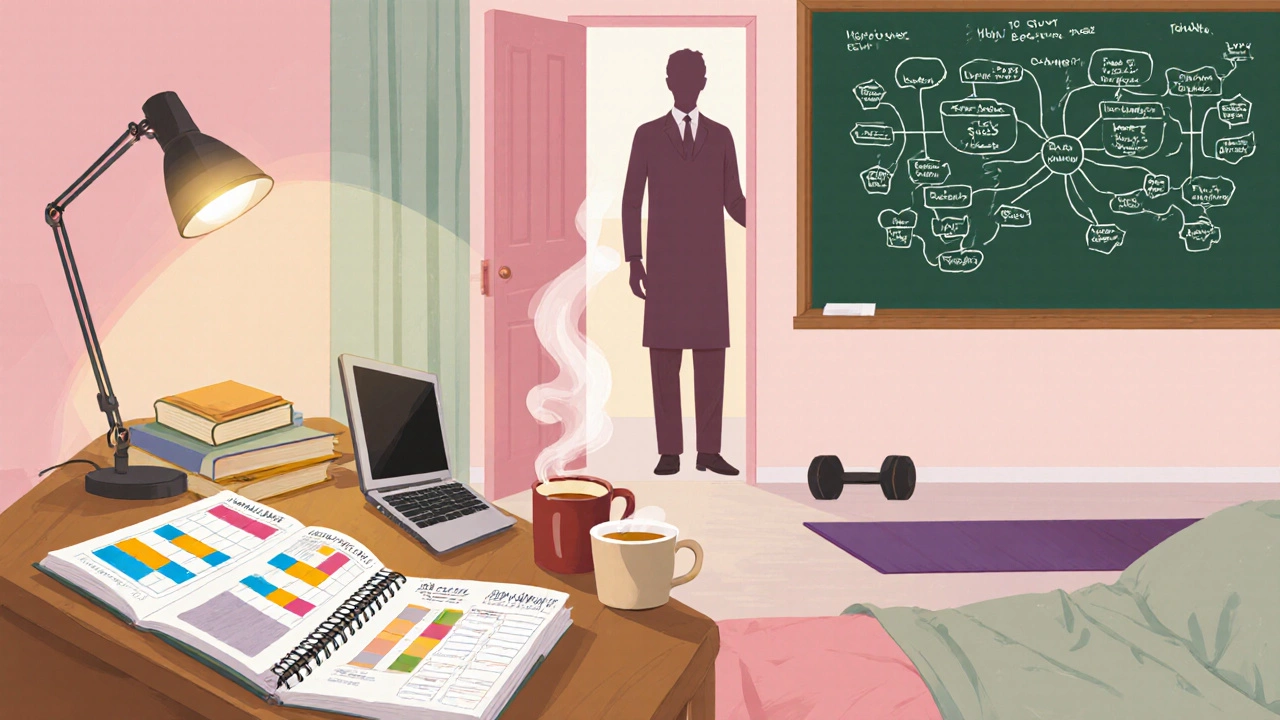College Major Difficulty Calculator
How it works
This calculator uses the same criteria from the article to assess major difficulty. Enter your scores (1-10 scale) for each dimension to get a total difficulty rating.
Difficulty Rating
When you hear the phrase hardest major, the mind instantly pictures endless problem sets, grueling labs, and a relentless beat of exams. But what actually makes a major hard? Is it the sheer volume of material, the competition to get in, the grading curve, or a mix of all three? This guide pulls apart those factors, ranks the toughest majors in India and abroad, and gives practical tips for anyone brave enough to tackle a demanding course of study.
How We Judge Difficulty
First things first-how do we decide what’s “hard”? We look at four measurable dimensions:
- Entry competition: the selectivity of the entrance exam or admission process.
- Curriculum intensity: average weekly contact hours, lab sessions, and fieldwork.
- Assessment rigor: proportion of final grade coming from high‑stakes exams versus continuous assessment.
- Graduate outcomes: pass rates and average time to degree completion.
By assigning a score to each dimension and weighting them, we can compare majors on a common scale.
Entry Competition: The Gatekeepers
In India, the most notorious gatekeepers are the IIT JEE an entrance exam for engineering institutes like the Indian Institutes of Technology and the NEET National Eligibility cum Entrance Test for medical colleges. Both have acceptance rates below 2 % for the top institutions. The AIIMS All India Institute of Medical Sciences, a premier medical institute admission cut‑offs are even steeper, often requiring rank < 500 out of 1 million candidates.
For civil services aspirants, the UPSC Union Public Service Commission exam for Indian administrative services is a marathon spanning three stages, with a final success rate of around 0.2 %.
These entrance exams set the tone: if getting in feels like climbing a mountain, the climb inside the program is often just as steep.
Curriculum Intensity: Hours in the Trenches
Engineering programs typically demand 30-35 contact hours per week, plus weekly lab sessions that double as practical evaluation. For example, a B.Tech in Mechanical Engineering at a top institute includes three labs a week, each lasting three hours, plus a 12‑hour design project that spans the semester.
Medical degrees, on the other hand, blend lecture hours with clinical rotations. The MBBS curriculum in India totals around 8,500 hours over five years, with the final two years spent in hospitals on nonstop shift work.
Physics and Mathematics majors at research‑intensive universities often feature graduate‑level problem sets that require abstract thinking and proof writing. A typical Quantum Mechanics course might allocate 15 lecture hours but expect students to spend 20-30 hours on weekly problem sets.
Architecture students juggle studio time, technical drawings, and history seminars, often pulling 50‑hour weeks during design studios.
Assessment Rigor: The High‑Stakes Factor
In engineering, the final grade is frequently a 70 % weighted final exam. Miss a few questions, and you could drop below the passing mark. Medicine’s assessment blends theory exams (30 %) with practical exams and clinical evaluations (70 %). The practical part is unforgiving-one missed skill can cost you dearly.
Computer Science programs increasingly use project‑based assessment, but flagship courses like Algorithms still rely on a 100‑point mid‑term and final each worth 40 % of the grade.
For UPSC, the three‑stage process (Pre‑lims, Mains, Interview) means a single slip in any stage can end the journey, despite years of preparation.

Graduate Outcomes: Completion Rates
Data from the Ministry of Education shows that the average on‑time graduation rate for engineering is about 78 %, while for medicine it drops to 62 % due to rigorous clinical requirements. Physics and Mathematics see the lowest on‑time rates-around 55 %-largely because many students switch to industry or research after the first two years.
Architecture programs report a 70 % completion rate, but many graduates take additional internships to bolster their portfolios.
The Top Hardest Majors, Ranked
| Major | Key Entrance Exam | Average Weekly Contact Hours | Assessment Weight (Final Exam) | On‑Time Graduation Rate |
|---|---|---|---|---|
| Engineering | IIT JEE | 30-35 hrs | 70 % | 78 % |
| Medicine | NEET / AIIMS | 35-40 hrs (incl. clinical) | 70 % | 62 % |
| Physics | JEE Advanced (for IITs) | 25-30 hrs | 60 % | 55 % |
| Mathematics | JEE Advanced | 25-30 hrs | 60 % | 55 % |
| Computer Science | JEE Main / Advanced | 28-34 hrs | 50 % (project heavy) | 70 % |
| Architecture | NATA / JEE (Some institutes) | 40-45 hrs (studio) | 65 % | 70 % |
These numbers paint a clear picture: engineering and medicine sit at the top of the difficulty ladder, followed closely by pure sciences and architecture.
Why Some Majors Feel Even Harder Than the Data Suggest
Beyond raw statistics, perception plays a role. Students often report that the mental fatigue from constant problem‑solving in physics or the emotional toll of patient interactions in medicine adds an invisible layer of difficulty. Peer pressure, family expectations, and the stigma of dropping out also weigh heavily.

Tips to Survive and Thrive in a Hard Major
- Plan Your Week: Block out study slots, lab hours, and recovery time. A visual calendar prevents overload.
- Master the Basics Early: In engineering, solid calculus and physics fundamentals reduce future friction.
- Form Study Groups: Collaborative problem solving accelerates learning, especially for proof‑based subjects like mathematics.
- Use Past Papers: For JEE, NEET, or UPSC, practicing with previous years’ papers reveals exam patterns and reduces surprise.
- Seek Mentors: Senior students, professors, or professionals can guide you through the most confusing topics.
- Prioritize Health: Regular sleep, exercise, and short breaks improve retention and stave off burnout.
Remember, the goal isn’t just to survive the major but to build a foundation that will serve you long after graduation.
When to Rethink Your Choice
Choosing a major is a commitment, but it’s not a prison sentence. If you consistently score below 40 % in core assessments, feel chronic anxiety, or lose passion for the subject, consider these steps:
- Talk to an academic advisor about switching tracks.
- Explore interdisciplinary programs that blend your interests (e.g., Biomedical Engineering for a medicine‑engineer hybrid).
- Take a semester off for an internship or research project to gain real‑world perspective.
Data from the National Survey of Student Experience (2024) shows that 12 % of students who changed majors in the first year reported higher satisfaction scores after the switch.
Future Outlook: Will the Hardest Majors Change?
The landscape evolves with technology. As AI takes over routine coding tasks, Computer Science may shift focus toward ethics and AI governance, potentially altering its difficulty profile. Likewise, the rise of online medical simulations could ease some clinical pressures in medicine.
However, the core challenges-deep conceptual understanding, rigorous assessment, and high competition-are unlikely to disappear overnight. Preparing for a hard major remains a blend of strategic planning, disciplined study, and personal resilience.
Which major has the toughest entrance exam in India?
The IIT JEE (now JEE Advanced) is widely regarded as the most demanding engineering entrance test, with a success rate under 2 % for the top IITs.
Is medicine harder than engineering?
Both are extremely demanding but in different ways. Medicine combines massive content volume with intensive clinical rotations, while engineering leans heavily on high‑stakes exams and complex problem sets. Difficulty often depends on personal strengths.
Can I switch from a hard major to a lighter one later?
Yes. Most universities allow credit transfers or a change of department after the first year, though you may need to meet prerequisite requirements for the new program.
How much time should I spend on weekly study for a hard major?
Aim for 25-35 hours of focused study outside of class, plus additional time for labs, projects, or clinical duties. Adjust based on assignment deadlines and personal retention rates.
Do online courses make these majors easier?
Online resources can supplement learning, but they don’t replace the core curriculum, lab work, or exam pressure that define these majors. They’re best used as extra practice.


